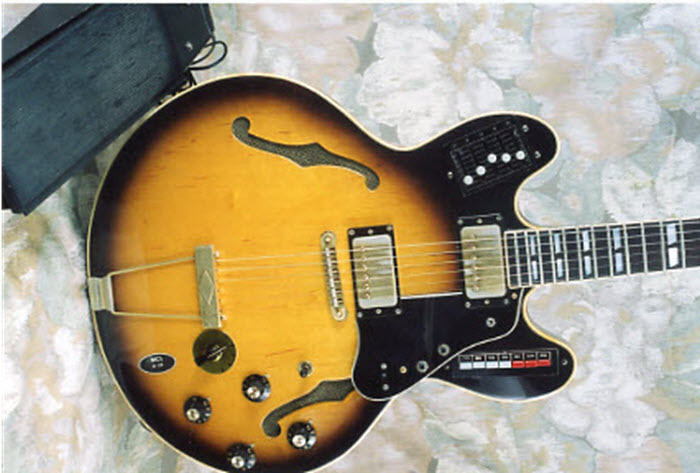
I confess I’ve not spent much of my life ice skating. Oh, I’ve been to ice skating rinks, but I don’t know, going around in circles on sore ankles just never turned me on. And there was always that queer, loud, ballparkish organ music in the foreground, if you’re lucky (or not), played by a live organist. I might have felt differently if the musician had been a guitarist. Or, rather, a Guitorganist!
The Guitorgan has to be one of the front-runners in the race for weirdest guitar concept ever, and there’s a lot of competition! Yeah, it comes dressed up in pretty normal-looking guitar’s clothing, but after that any resemblance melts away.
I was quite surprised to learn that the Guitorgan concept was around before 1962, when inventor Robert Murrell of Waco, Texas, filed for a patent on the instrument. In a nutshell, Murrell’s idea was simple. Take an electronic organ. You press a key and that makes an electrical connection that sends a signal to whatever tone generator circuit you’ve selected using the frequency location of that key. So, why couldn’t you do the same thing with a guitar? Of course, an electric guitar is just an acoustic guitar with an electro-magnetic pickup that translates the interruption of its magnetic field by vibrating steel strings to generate an electronic signal. That’s actually a far more complex connection, and irrelevant. Suppose we wire the frets so that the electronic connection is made there? The problem is that the fret touches all 6 strings, so you can’t distinguish the frequency or pitch. Solution: cut the frets into 6 segments and wire each segment separately. Then at each touchpoint you get a different, distinct pitch. Run this through some real organ circuitry and you have a Guitorgan!
Well, it’s more complicated than that, but that’s the basic idea. In 1966 or so, Bob Murrell began working with engineers at Baldwin in Cincinnati to figure out how to adapt their organ electronics to fit into a guitar. By 1967 he’d developed a prototype with his partner Bill Mostyn and took it to NAMM in Chicago, where the guitar was played by one Bob Wiley. We don’t know what kind of guitar was used, but they obviously favored hollowbodies. There was enough interest that they went home and began making Guitorgans in the garage, forming a company called MusiConics, opening a factory in 1968, and beginning production in 1969.
Over the years Guitorgan used a number of hollowbody guitars to mount its electronics. Most were Japanese, including a Barnie Kessel model and various ES-335 copies. Online sources say that there were some examples using American guitars produced by Kapa in Maryland, but that would be pretty curious. By the time Guitorgans were produced, Kapas were Japanese hollowbodies with U.S.-made necks that were extraordinarily thin. When you have to mount wires in the neck, thin isn’t better. Besides, Kapas barely made it into the 1970s. Who knows?
What’s even more surprising is that online sources suggest that approximately 3,000 Guitorgans were produced from 1969-1984. I find it really hard to buy that quantity, both because I can’t imagine 3,000 guitarists wanting to play one and because you almost never see them.
And, because the control options are almost mind-boggling. You got flute/accordion/vibes voices, with six register controls for flute mode alone. You got an organ/combo switch with tuning wheel to synchronize guitar and organ. You got a button for open E to tune. You got a button to temporarily activate organ when in guitar mode. You got voice controls for percussive, sustain, tremolo and octave lower. You got a button at the nut to activate the open string while fingering (this may be the weirdest feature of all!). Plus stereo output. And a 5-pin jack to connect to an organ. And a transformer/volume pedal. Not to mention on the guitar side you get standard controls PLUS a 6-position varitone. I don’t know about you, but this is way too much information to process in the middle of Apache. Did I mention a $2,500 to $4,000 price tag?
MusiConics did make Guitorgans from 1969-1984, and on a custom-order basis, including with a MIDI option, into the late 1980s. But three thousand musicians bought these? You decide…
This is a well-made guitar, probably built by FujiGen Gakki, the maker of Ibanez guitars. It’s a B-35 model probably from around 1977.
I love the idea of this guitar—er, organ—but it’s over the top. You might be able to find one, but good luck. If you want to hear what a Guitorgan sounds like, look for Dan Forte’s CD The Many Moods of Teisco Del Rey (Upstart Records, 1992), if you can find that, as well. As for playing at the local rink, I think I’d rather be skating, ankles be darned…

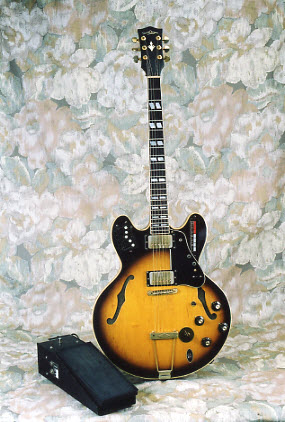
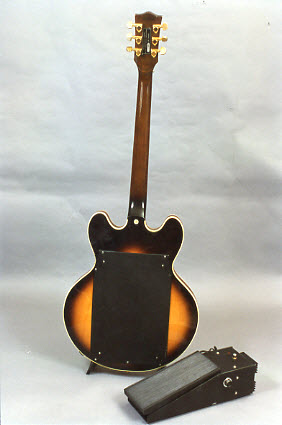
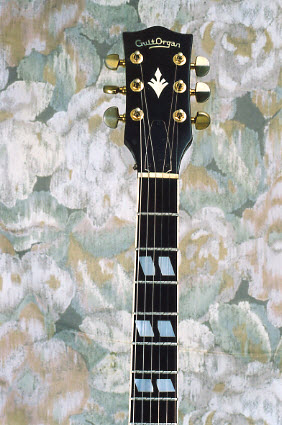
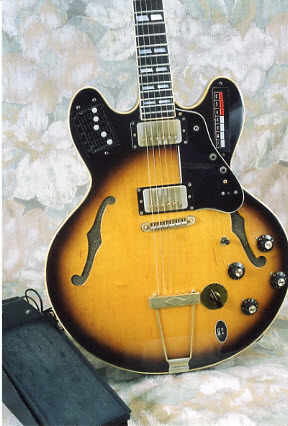
I saw and heard a very good guitarist play a Guitorgan, and the sound was fantastic. The guitarist
didn’t seem to have any problem playing it. It was his primary guitar. I have been trying to come
across another one without any luck. But the sound and tone of the only one I saw and heard was
tremendous (for the time) (@ 1980 or so)
In the late 70s I was living in hardly-musical-Mecca (Paducah, KY). There was a local guy — Berklee guitar grad, at that — who used his Guitorgan for supper gigs at a local lounge, sometimes backing a female vocalist: “Tie a Yellow Ribbon,” “Delta Dawn,” etc.
Surreal.
btw, just in case you didn’t already know, there are some youtube vids of Teisco Del Rey (the guy, not the company) with his Guitorgan.
I got to see if I can find one being played on YouTube. Maybe, they got everything on YouTube.
How can you show us the guitar and write this article but fail to have an audio/video take on it?
Mark Farner of Grand Funk Railroad, who you are aware of with your Messenger copy, played one of these on their “Shinin’ On” album, along with his all aluminum Veleno. Every damn guitar that guy played is now worth many times it’s original price(Messenger, Micro-Frets, Veleno, Gibson L5-S-the most beautiful solid body ever). I think it’s on the song “Getting Over You”. I live in Maryland and in the 70’s I saw one in a local music store, so the MD connection might be real. Sadly, I was was a kid and they wouldn’t let me play it. Oh, and make copies of all of Mark’s guitars!
I fooled around with one in the early 70’s. Sounded awfully “glitchy” unless you had the specific technique down. Seemed more sensible to me to just get a combo organ. And for the money, you could.
Just search guitorgan on You Tube. They are out there.
I saw a guitarist working with only a drummer, kicking a Fender Pedal Bass and playing a GuitOrgan. Doing “Black Magic Woman,” both the organ arpeggios and Santana’s licks. He let me play a couple songs on it after learning I also kicked bass. It really did sound good for its time.
Found this link on Vox’ homepage.
http://youtu.be/RtUrpzkfeuI
Seems others went on to use the idea.
I have a B300 and love it. There’s a certain way to play it with effects that can get very “Floydy”. However I’ve had to repair some stuff on it and it’s been a nightmare. Does anyone know anyone that really works on these? I’m in need!
Cheers, Steve
I bought a B35- S in ’79. The “s” designation means that for only $700.00 extra I got a Steiner analog synth with it. The guitar put out the control voltage from a second 1/4″ jack. I played it ’till I wore the frets off and sold it to a friend. He had it professionally rebuilt and hung it on his wall. It’s been hanging there for over 25 years, but I’m dealing with him to get it back 🙂 Maybe as soon as next payday (if I’m lucky) I want to mount my Fishman triple play on it and have the worlds most electrified electric guitar even if my hands are getting too stiff to play it properly. ….Some people just don’t know when to quit, I guess.
Before I got the guitorgan I had one of the previously mentioned Microfrets (green spacetone with wireless) I know where it is, but I can’t make a deal on it.
My Dad owned a music store in Ohio for several decades and was a Guitorgan authorized dealer for Ohio, Indiana and Kentucky. He also played one every weekend (I played with him) for 15 years or so. To play the organ part didn’t require strumming the guitar part so he could work the draw bars and get a sort of wah-wah sound.
I went with him to the factory in Wako several times to see them built. He and Murrell became close friends and business buddies. If I recall, I think it was he and Dad that designed and built what they call the Rotronic. It was an amplifier for the Guitorgan that was based on the Leslie cabinet idea that it had a spinning deflector mounted above an upward facing speaker. They stand about 2 foot tall and about 14 inches square. They sound pretty cool combined with the Guitorgan. They didn’t sell like hotcakes or anything but they sold more than a few.
Dad passed away on 2000 and I wish I had his Guitorgan. I do however have the Guitorgan light/clock that hung in his store and I also have his Rotronic amplifier.
I own a guitorgan – I have had it since 1974 – I played in a dance band for 17 years – it was great – I learned how to play it pretty quickly – I even did a one man show using the bass pedals and drum machine which were options one could purchase at additional cost – you have to think organ and guitar at the same time – most guitar players can’t do that which is one reason it didn’t sell that well – it was also very expensive $2500 – in 1974 – and it is quite heavy – three or four hours playing this instrument is not for the faint of heart – it takes some muscle and stamina – especially it you are standing up during the gig. It may not have a lot of value in todays market but it is worth a lot to me – lots of great memories – you can’t put a price on that.
I have had two Guitorgans and still have the second one I purchased (used) the first one I bought was new (at a cost of $4,500 back then. I played it professionally for several years before selling it to a teenage student of mine. He played it professionally (earned enough to pay for his university education) He is about to retire now and he still has that Guitorgan…:.
I have five b300 guitorgan at 74 I still do a single with bass pedals drum machine and harmony machine for vocals the man that kept them working for me passed away I’d like to find a recognition that understands and can fix them
I have a B-35 identical to this…but with NO ORGAN ELECTRONICS…its an ES345 copy, straight forward. what’s this worth? any way to tell?? any way to date the guitar??
I’ve got a couple B-300’s and a B35. A tech in LA named Tim Conniff ruined one of the B-300’s and Ed Miller, who used to work on mine just retired. I’d love to find a tech anywhere in the country. These are marvelous, unique instruments that still have unexplored sonic frontiers.
Steve taylorsteve@gmail.com
http://www.stevetaylormusic.com
I’m the student Doug MacLean mentions above and yes, I still have it. The key for me to avoid glitching was to keep the strings and frets absolutely clean. I used to clean them with electrical contact cleaner each night before I used it.
I also have a guitorgan . It was left to me by my stepfather & best friend . I have never played it & dont know if it is in full working order but , if anyone would know anything about them or is interested please email me & I will get back to you . Thank you